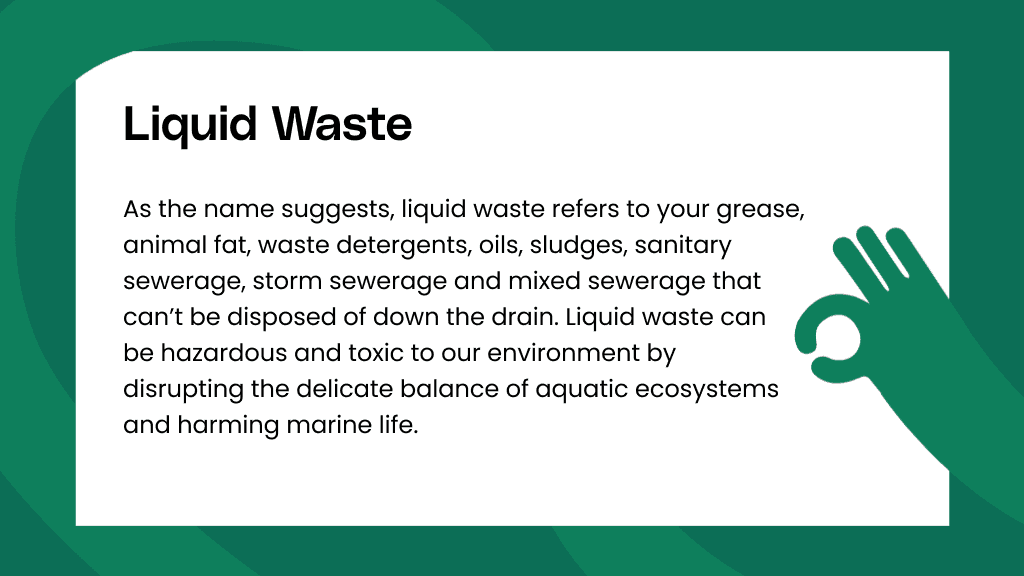Our Reclaim Waste PDFs
Our Reclaim Waste PDFs
Blog Article
Some Known Questions About Reclaim Waste.
Table of ContentsReclaim Waste Can Be Fun For AnyoneGetting The Reclaim Waste To WorkAll About Reclaim WasteThe Single Strategy To Use For Reclaim WasteThe Ultimate Guide To Reclaim Waste
Check out the types, events, and types of liquid waste. Domestic sewer waste describes the waste and items from a property septic system. This kind of waste is developed by human beings in houses, schools, and various other buildings. This only includes sewage-disposal tanks that have a drainpipe field. The correct administration and disposal of residential sewer waste need fluid waste to be transferred to a sewer therapy plant where the proper techniques and tools are applied to detoxify and take care of waste.
Business waste usually includes possible hazards, such as combustible materials or a blend of fluid and solid waste items, and requires an advanced and in-depth disposal procedure. The disposal of business waste generally entails the filtration of waste prior to transportation to make sure secure and appropriate disposal. Hazardous waste is developed from byproducts and overflow of commercial procedures and manufacturing.
This sort of waste can not use the same sewage monitoring transport or procedures as septic or industrial liquids. The industrial waste monitoring process needs the assessment and testing of fluid waste prior to it undertakes the disposal procedure (liquid waste removal). Overflow waste is the fluid waste that originates from drainage and excess stormwater in very populated areas or cities
Overflow waste can cause contamination and flooding if not taken care of properly. Find out more concerning sewage system cleansing and waste monitoring. Making sure proper waste management can protect against calamities and lower ecological injury. Both people in household setups and professionals in business or production industries can gain from understanding the processes and regulations of liquid waste monitoring.
Top Guidelines Of Reclaim Waste
Get in touch with PROS Solutions today to learn more about our waste administration and disposal solutions and the proper means to care for the liquid waste you generate.
(https://slides.com/reclaimwaste1)Do you recognize what takes place to your water when you end, flush the bathroom or drain pipes the cleaning machine? No? Well, it deserves understanding. This so-called 'wastewater' is not only a vital source but, after treatment, will certainly be released to our land, waterways or the ocean. Used water from commodes, showers, bathrooms, kitchen area sinks, washings and industrial processes is called wastewater.

water used to cool down machinery or tidy plant and equipment). Stormwater, a kind of wastewater, is overflow that moves from farming and urban locations such as roofings, parks, yards, roadways, courses and gutters right into stormwater drains pipes, after rain. Stormwater streams neglected directly to neighborhood creeks or rivers, eventually reaching the sea.
Reclaim Waste Fundamentals Explained
In Queensland, the majority of wastewater is dealt with at sewer therapy plants. Wastewater is delivered from residential or commercial websites via a system of sewage systems and pump terminals, understood as sewage reticulation, to a sewer therapy plant.
The Department of Natural Resources advises regional governments about managing, operating and maintaining sewerage systems and therapy plants. In unsewered locations, local federal governments might need householders to install individual or home sewage treatment systems to deal with residential wastewater from bathrooms, kitchen areas, washrooms and washings. The Department of Natural Resources authorises making use of house systems when they are proven to be effective.
In some brand-new communities, treatment of some stormwater to eliminate clutter, sand and gravel has started utilizing gross pollutant catches. Wastewater treatment occurs in 4 phases: Gets rid of solid issue.
Wastewater then moves right into large storage tanks where solids resolve and are like this eliminated as sludge. Oil and scum are skimmed from the surface. Makes use of small living microorganisms referred to as micro-organisms to break down and eliminate continuing to be dissolved wastes and fine fragments. Micro-organisms and wastes are integrated in the sludge. Gets rid of nitrogen and phosphorus nutrients that might create algal flowers in our rivers and endanger marine life.
The Definitive Guide to Reclaim Waste
Nutrient removal is not offered in any way sewage treatment plants due to the fact that it calls for expensive specialized devices. It is becoming much more usual in Queensland. Clear liquid effluent produced after treatment may still consist of disease-causing micro-organisms. If this effluent is launched right into waterways such as rivers or the sea, the micro-organisms will eventually die out.

Most wastewater moves into the sewage system. Under the Act, regional governments provide approvals and permits for ecologically relevant activities (ERAs) including wastewater releases that may have a local influence.
The 5-Minute Rule for Reclaim Waste
Surveillance offers factual information concerning water quality and can confirm that licence conditions are being satisfied. The details gotten via surveillance offers the basis for making water high quality decisions.
Report this page